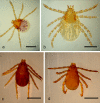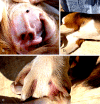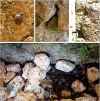Biology and ecology of the brown dog tick, Rhipicephalus sanguineus
- PMID: 20377860
- PMCID: PMC2857863
- DOI: 10.1186/1756-3305-3-26
Biology and ecology of the brown dog tick, Rhipicephalus sanguineus
Abstract
The brown dog tick (Rhipicephalus sanguineus) is the most widespread tick in the world and a well-recognized vector of many pathogens affecting dogs and occasionally humans. This tick can be found on dogs living in both urban and rural areas, being highly adapted to live within human dwellings and being active throughout the year not only in tropical and subtropical regions, but also in some temperate areas. Depending on factors such as climate and host availability, Rh. sanguineus can complete up to four generations per year. Recent studies have demonstrated that ticks exposed to high temperatures attach and feed on humans and rabbits more rapidly. This observation suggests that the risk of human parasitism by Rh. sanguineus could increase in areas experiencing warmer and/or longer summers, consequently increasing the risk of transmission of zoonotic agents (e.g., Rickettsia conorii and Rickettsia rickettsii). In the present article, some aspects of the biology and ecology of Rh. sanguineus ticks are discussed including the possible impact of current climate changes on populations of this tick around the world.
Figures








References
-
- Hoogstraal H. Argasid and nuttalliellid ticks as parasites and vectors. Adv Parasitol. 1985;24:135–238. full_text. - PubMed
-
- Marcondes CB. Doenças transmitidas e causadas por artrópodes. São Paulo: Editora Atheneu; 2009.
-
- Jongejan F, Uilenberg G. The global importance of ticks. Parasitology. 2004;129(Suppl 1):S3–S14. - PubMed
LinkOut - more resources
Full Text Sources
Molecular Biology Databases

